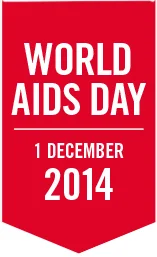This year we have seen palpable progress in the fight against AIDS, and also some astonishing hucksterism. In celebration of World AIDS Day 2014, here are 10 of the most influential trends in HIV this year.
1. The cure, and its pretenders. To date only one person has ever been cured of HIV infection: Timothy Ray Brown, a resident of Berlin who received a CCR5-deleted bone marrow transplant while on potent anti-HIV medications. Recently we heard the word "cure" applied frequently but ultimately falsely to the Mississippi baby and some patients given ordinary bone marrow transplants. Everyone but Timothy has relapsed. Next year let's use the "C" word with caution, and for a great book on the search for a cure, try Cured: How the Berlin Patients Defeated HIV and Forever Changed Medical Science by Nat Holt.
2. A new model for AIDS. As I summarized in the Scientific American, Warner Greene's lab unleashed simultaneous papers in Science and Nature in late 2013 that upend how we understand the pathogenesis of AIDS. Through a stroke of luck reminiscent of the early identification of AZT - in which a promising new drug was already sitting on the shelf as a result of unrelated cancer research - Greene's group even moved a promising new approach to HIV treatment into clinical trials.
3. Better ART. Speaking of antiretroviral therapy (ART), the three-in-one antiretroviral drug Atripla has long been king of the HIV treatment hill. This changed with the late 2013 publication of the SINGLE trial in which a new combination drug (dolutegravir/abacavir/lamivudine) was safer and more effective than Atripla. This - and other similar studies in new HIV treatment options - has driven yet another shift in HIV treatment as patients have more and more ways of living long lives on good HIV medicine. This is cause for celebration, but we should not forget that most people with HIV can't access these treatments for one reason or another.
4. Do we really need all those CD4's? For years doctors have checked CD4 counts with every clinical visit, and patients have grown accustomed to that regular gauge on how they're doing. Yet as life expectancy on antiretroviral therapy gets longer and clinical visits become less frequent, many HIV docs have realized those faithfully-plotted CD4 counts aren't guiding our decisions for patients with suppressed HIV viral loads and strong immune systems. As a result, new guidelines make CD4 count monitoring "optional" for some patients - and I think it should be optional for more.
5. Hope for hepatitis C. HIV treatment successes weren't the only reason for hope this year. Drug development for hepatitis C has also progressed dizzyingly quickly. Multiple new effective regimens have been released recently, including some with equivalently near-perfect efficacy in people with HIV. Treatment is still complicated, but when the smoke clears and we work out the considerable financial obstacles to widespread treatment, many expect these potent new drugs to put a huge dent in the hepatitis C epidemic.
6. The high potential and personal politics of PrEP. A key recent boon to the fight against AIDS has been the discovery that HIV drugs can safely protect many high risk people from HIV infection. In a huge boon to HIV prevention, pre-exposure prophylaxis (PrEP) has been proven to protect men who have sex with men, heterosexual men and women, and people who inject drugs from HIV. Recent WHO guidelines suggested "All men who have sex with men should have the opportunity to choose PrEP if they feel that it meets their HIV prevention needs" whereas the CDC guidelines recommended PrEP to groups that hew more closely to populations in whom PrEP showed proven protection. Political commentary has been plentiful, and new clarified WHO guidelines are due out soon, so the PrEP conversation is sure to rage on.
7. A shot in the arm for vaccines. Many HIV vaccine candidates have fizzled out in clinical trials, including the much-lauded Merck adenovirus vaccine which may have increased the risk of HIV infection. Fortunately the 2009 Rv144 trial showed a protective HIV vaccine is possible, and subsequent studies showed that certain antibody levels correlated with HIV protection among vaccine recipients. This has fueled a new phase of HIV vaccine research, with many new candidates now in clinical trials built on what we have learned in the past few years.
8. Stagnant funding. For years the United States has been the major funder of the global HIV response. Yet on the heels of the global financial crisis, and a diversification of PEPFAR funds, HIV funding has stagnated and experts fear there is a growing gap between the global HIV need and our ability to address it. Will we look at this year as the beginning of the end of HIV, or the year we started to turn away from the dream of zero HIV?
9. Progress for children. Children are our most precious resource. We have a long way to go, but everybody welcomed the wonderful news from UNICEF that new HIV infections in children have dropped by 40%. Hallelujah!
10. A PROMISE for pregnant women. There was good news this year for both children and mothers with HIV. This fall, a pivotal clinical trial called PROMISE was closed early when it showed that full antiretroviral therapy is better for new mothers with HIV. It also surprised many of us by showing a dark horse regimen was best. The ethics of the trial were hotly contested, as I wrote recently in Health Affairs, but ultimately the results of the PROMISE study will help drive global HIV policy in the right direction for years to come.
2014 was a great year for HIV. We saw real progress, we made startling new discoveries, and the HIV community remains as vibrant as ever. Would you have chosen the same top 10 trends in HIV for 2014?

![[ M U R M U R S ]](http://images.squarespace-cdn.com/content/v1/51efa33ce4b09afa04cb2a66/1376911411704-LDY4UEIH1WRGPUXTMLJU/Logo.jpg?format=1500w)



